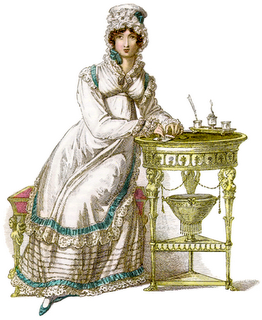
The Mirror of Graces, written by a Lady of Distinction in 1811, is a first-hand source that describes the dress and manners of ladies during the Regency Period. Some speculate that the book was written by a governess or lady's companion who was a close observer of the upper classes, but not a member of it.
Here is her observation on "the detail of dress."
"The mantle, or cottage-cloak, should never be worn by females exceeding a moderate en bon point; and we should recommend their winter garbs, such as Russian pelisses and Turkish wraps, to be formed of double sarsenet, or fine Merina cloth, rather than velvets, which (except black) give an appearance of increased size to the wearer. In the adoption of furs, flat-ermine or fringe fur is better suited to the full-formed woman than swan's down, fox, chinchilli, or sable; these are graceful for the more slender. Women of spare habit, and of a tall and elegant height, will derive considerable advantage from the full-flowing robe, mantle, and Roman tunic. The fur trimming, too, gives to them an appearance of roundness, which nature has denied;and to this description of person we can scarcely recommend an evending-dress more chaste, elegant and advantageous, than robes of white satin trimmed with swan's-down, with draperies of silver or gossamer net."
Find a listing of fabric and cloth on the Phrontistery site:
"This is a rather odd category, listing 269 names of kinds of fabric and cloth. There is an enormous variety in fabrics, with many different national, historical and regional varieties. It is interesting to note, however, that almost all of the types of fabric listed below are variants or blends of just five basic fabric types (silk, cotton, linen, wool and worsted)."

No comments:
Post a Comment